Bilimbi
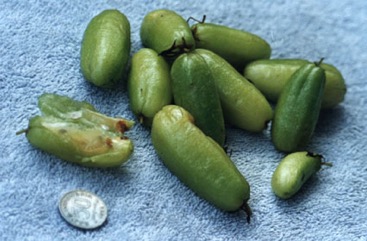
A tropical plant. It suits the hot, wet tropical lowlands. The tree is drought resistant. It will grow from sea level up to at least 750 m altitude in the tropics. It prefers well composted, moist soil, in a protected, partly shaded position. It is frost tender. In the Cairns Botanical Gardens. It suits hardiness zones 10-12. At MARDI.
Also known as:
Belimbing asam, Belimbing besi, Belimbing buluk, Belimbing masam, Belimbing wuluh, Bilamagu, Bilimagu, Bilimbing wuluh, Bilin, Bilombitenga, Birinbi, Camia, Cornichonier, Cucumber tree, Iba, Kamias, Kamis, Kamrakh, Khe tau, Kochittamarattai, Lange birambi, Limao-de-Caiena, Limon chino, Mbilimbi, Pohon belimbing wuluh, Shiyam, Sour finger carambola, Taling pling, Tayok-zaungya, Tralong tong, Trolung tung
Synonyms
- Averrhoa abtusangulata Stokes
- Averrhoa obtusangula Stokes
Edible Portion
- Fruit, Flowers, Spice
Where does Bilimbi grow?
Found in: Africa, Amazon, Andamans, Asia, Australia, Bangladesh, Brazil, British Indian Ocean Terr., BIOT, Cambodia, Central America, China, Costa Rica, Cuba, Dominican Republic, East Africa, East Timor, Fiji, Ghana, Grenada, Guam, Guyana, Haiti, Hawaii, India, Indochina, Indonesia, Jamaica, Laos, Malaysia, Maldives, Mariana Islands, Mexico, Mozambique, Myanmar, Nauru, Nicaragua, Northeastern India, Pacific, Pakistan, Palau, Papua New Guinea, PNG, Peru, Philippines, Pohnpei, SE Asia, Singapore, Solomon Islands, South America, Sri Lanka, St. Vincent and Grenadines, Suriname, Taiwan, Tanzania, Thailand, Timor-Leste, United States, Vietnam, West Africa, West Indies, West Timor
Notes: There are 5 Averrhoa species. Sometimes Averrhoa are put in the Averrhoaceae family.
Status: Only of minor use as a flavouring in cooking. It is common in India and south Asia. Occasional trees occur in Papua New Guinea and the fruit is probably little used.
Growing Bilimbi
Cultivation: Trees are mostly grown from seeds. It grows wild in secondary forest in many coastal areas. It can also be grown by air layering.
Edible Uses: The fruit are used for souring dishes. They can also be used for jams, drinks, pickles and in curries. The flowers can be made into conserves.
Production: Flowers are produced all year round. Flowering is more common in dry seasons. Plants produce fruit after 5-6 years/ Fruit mature in 90 years. A tree can produce 500 fruit in a year.
Nutrition Info
per 100g edible portion| Edible Part | Energy (kcal) | Protein (g) | Iron (mg) | Vitamin A (ug) | Vitamin c (mg) | Zinc (mg) | % Water |
|---|---|---|---|---|---|---|---|
| Fruit | 20 | 0.8 | 1 | 30 | 16 | - | 94.2 |
| Flowers | - | - | - | - | - | - |
Bilimbi Photos

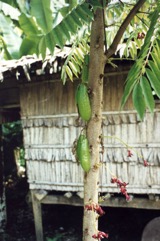
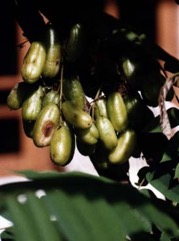
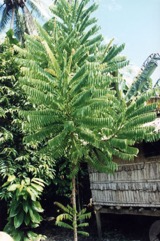
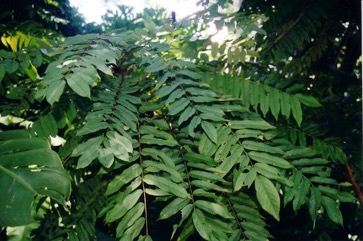
References
AAK, 1980, Bertanam Pohon Buah-buahan. Penerbitan Yayasan Kanisius, Jogyakarta. p 16
Abbiw, D.K., 1990, Useful Plants of Ghana. West African uses of wild and cultivated plants. Intermediate Technology Publications and the Royal Botanic Gardens, Kew. p 42
Ambasta S.P. (Ed.), 2000, The Useful Plants of India. CSIR India. p 63
Arora, R. K., 2014, Diversity in Underutilized Plant Species - An Asia-Pacific Perspective. Bioversity International. p 59
Baishya, S. Kr., et al, 2013, Survey of Wild Edible Fruits of Dhubri District, Assam, India. Plant Archives Vol 13 (1): 155-158
Barwick, M., 2004, Tropical and Subtropical Trees. A Worldwide Encyclopedic Guide. Thames and Hudson p 39
Bircher, A. G. & Bircher, W. H., 2000, Encyclopedia of Fruit Trees and Edible Flowering Plants in Egypt and the Subtropics. AUC Press. p 49
Bodkin, F., 1991, Encyclopedia Botanica. Cornstalk publishing, p 120
Brouk, B., 1975, Plants Consumed by Man. Academic Press, London. p 163
Brown, W.H., 1920, Wild Food Plants of the Philippines. Bureau of Forestry Bulletin No. 21 Manila. p 72
Burkill, H. M., 1985, The useful plants of west tropical Africa, Vol. 4. Kew.
Burkill, I.H., 1966, A Dictionary of the Economic Products of the Malay Peninsula. Ministry of Agriculture and Cooperatives, Kuala Lumpur, Malaysia. Vol 1 (A-H) p 272
Chakraborty, S. & Chaturbedi, H. P., 2014, Some Wild Edible Fruits of Tripura- A Survey. Indian Journal of Applied research. (4) 9
Chandrashekara, U. M., 2009, Tree species yielding edible fruit in the coffee-based homegardens of Kerala, India: their diversity, uses and management. Food Sec. 1:361-370
Chin, H.F., & Yong, H.S., 1996, Malaysian Fruits in Colour. Tropical press, Kuala Lumpur p 54
Coronel, R.E., 1982, Fruit Collections in the Philippines. IBPGR Newsletter p 6
Cundall, P., (ed.), 2004, Gardening Australia: flora: the gardener's bible. ABC Books. p 210
Darley, J.J., 1993, Know and Enjoy Tropical Fruit. P & S Publishers. p 21
Ekman Herbarium records Haiti
Facciola, S., 1998, Cornucopia 2: a Source Book of Edible Plants. Kampong Publications, p 45
Flora of Pakistan. www.eFloras.org
Flowerdew, B., 2000, Complete Fruit Book. Kyle Cathie Ltd., London. p 158
Food Composition Tables for use in East Asia FAO http://www.fao.org/infoods/directory No. 827
French, B., 1986, Food Plants of Papua New Guinea, Asia Pacific Science Foundation p 222
French, B.R., 2010, Food Plants of Solomon Islands. A Compendium. Food Plants International Inc. p 223
Garner, R.J., and Chaudhri, S.A., (Ed.) 1976, The Propagation of Tropical fruit Trees. FAO/CAB. p 29
Hedrick, U.P., 1919, (Ed.), Sturtevant's edible plants of the world. p 88
Heywood, V.H., Brummitt, R.K., Culham, A., and Seberg, O. 2007, Flowering Plant Families of the World. Royal Botanical Gardens, Kew. p 239
Hutton, W., 1997, Tropical Herbs and Spices of Indonesia. Periplus. p 14
Hu, Shiu-ying, 2005, Food Plants of China. The Chinese University Press. p 490
Jardin, C., 1970, List of Foods Used In Africa, FAO Nutrition Information Document Series No 2.p 122
Kiple, K.F. & Ornelas, K.C., (eds), 2000, The Cambridge World History of Food. CUP p 1731
Lembaga Biologi Nasional, 1977, Buah-Buahan, Balai Pustaka, Jakarta. p 20
Lembogi Biologi Nasional, 1980, Sayur-sayuran. Balai Pustaka, Jakarta. p 16
Llamas, K.A., 2003, Tropical Flowering Plants. Timber Press. p 306
Lorenzi, H., Bacher, L., Lacerda, M. & Sartori, S., 2006, Brazilian Fruits & Cultivated Exotics. Sao Paulo, Instituto Plantarum de Estuados da Flora Ltda. p 466
Macmillan, H.F. (Revised Barlow, H.S., et al) 1991, Tropical Planting and Gardening. Sixth edition. Malayan Nature Society. Kuala Lumpur. p 293
Martin, F. W., et al, 1987, Perennial Edible Fruits of the Tropics. USDA Handbook 642 p 44
Martin, M.A., 1971, Introduction L'Ethnobotanique du Cambodge. Centre National de la Recherche Scientifique. Paris
Miguel, E., et al, 1989, A checklist of the cultivated plants of Cuba. Kulturpflanze 37. 1989, 211-357
Morton, J. F., 1987, Fruits of Warm Climates. Wipf & Stock Publishers p 128
Pasha, M. K. & Uddin, S. B., 2019, Minor Edible Fruits of Bangladesh. Bangladesh J. Plant Taxon. 26(2): 299–313
Patiri, B. & Borah, A., 2007, Wild Edible Plants of Assam. Geethaki Publishers. p 20
Pawera, L., et al, 2020, Wild Food Plants and Trends in Their Use: From Knowledge and Perceptions to Drivers of Change in West Sumatra, Indonesia, Foods. 2020, 9, 1240
Phon, P., 2000, Plants used in Cambodia. © Pauline Dy Phon, Phnom Penh, Cambodia. p 54
PROSEA (Plant Resources of South East Asia) handbook, Volume 2, 1991, Edible fruits and nut. p 96
Ochse, J. J. et al, 1931, Vegetables of the Dutch East Indies. Asher reprint. p 547
Omawale, 1973, Guyana's edible plants. Guyana University, Georgetown p 44
Ong, H.C. et al, 2012, Traditional knowledge and usage of edible plants among the Temuan villagers, Malaysia. Indian Journal of Traditional Knowledge. 11(1) pp 161-165
Owen, S., 1993, Indonesian Food and Cookery, INDIRA reprints. p 49
Paul, A., 2013, Minor and uncultivated fruits of Eastern India, 2nd International Symposium on Minor Fruits and Medicinal Plants
Peekel, P.G., 1984, (Translation E.E.Henty), Flora of the Bismarck Archipelago for Naturalists, Division of Botany, Lae, PNG. p 265, 264
Plants of Haiti Smithsonian Institute http://botany.si.edu/antilles/West Indies
Purseglove, J.W., 1968, Tropical Crops Dicotyledons, Longmans. p 638
Rajapaksha, U., 1998, Traditional Food Plants in Sri Lanka. HARTI, Sri Lanka. p 348
Segura, S., et al, 2018, The edible fruit species in Mexico. Genet Resour Crop Evol (2018) 65:1767–1793
Seidemann J., 2005, World Spice Plants. Economic Usage, Botany, Taxonomy. Springer. p 59
Selvam, V., 2007, Trees and shrubs of the Maldives. RAP Publication No. 2007/12 p 34
Smith, N., Mori, S.A., et al, 2004, Flowering Plants of the Neotropics. Princeton. Plate 35 (Photo)
Solomon, C., 2001, Encyclopedia of Asian Food. New Holland. p 39
Sp. pl. 1:428. 1753
Staples, G.W. and Herbst, D.R., 2005, A tropical Garden Flora. Bishop Museum Press, Honolulu, Hawaii. p 446
Sujanapal, P., & Sankaran, K. V., 2016, Common Plants of Maldives. FAO & Kerala FRI, p 46
Sujarwo, W., et al, 2016, Traditional knowledge of wild and semi-wild edible plants used in Bali (Indonesia) to maintain biological and cultural diversity. Plant Biosystems, 2016, Vol. 150, No. 5, 971-976
Sukarya, D. G., (Ed.) 2013, 3,500 Plant Species of the Botanic Gardens of Indonesia. LIPI p 141
Sukenti, K., et al, 2016, Ethnobotanical study on local cuisine of the Sasak tribe in Lombok Island, Indonesia. Journal of Ethnic Foods. 3 (2016) 189-200 p 198
Suwardi, A. B., et al, 2020, Ethnobotany and conservation of indigenous edible fruit plants in South Aceh, Indonesia. Biodiversitas Vol. 21, No. 5, pp 1850-1860
Swaminathan, M.S., and Kochnar, S.L., 2007, An Atlas of Major Flowering Trees in India. Macmillan. p 86
Tankard, G., 1990, Tropical fruit. An Australian Guide to Growing and using exotic fruit. Viking p 105
Tate, D., 1999, Tropical Fruit. Archipelago Press. Singapore. p 32
Terra, G.J.A., 1973, Tropical Vegetables. Communication 54e Royal Tropical Institute, Amsterdam, p 27
Topp, J. M. W., 1988, An Annotated Check List of the Flora of Diego Garcia, British Ocean Territory. Atoll Research Bulletin No. 313
Tyagi, R. K., et al, 2004, Conservation of Spices Germplasm in India. Indian J. Plant Genet. Resour. 17(3): 163-174
USDA, ARS, National Genetic Resources Program. Germplasm Resources Information Network - (GRIN). [Online Database] National Germplasm Resources Laboratory, Beltsville, Maryland. Available: www.ars-grin.gov/cgi-bin/npgs/html/econ.pl (10 April 2000)
van Wyk, B., 2005, Food Plants of the World. An illustrated guide. Timber press. p 81
Vasquez, R. and Gentry, A. H., 1989, Use and Misuse of Forest-harvested Fruits in the Iquitos Area. Conservation Biology 3(4): 350f
Zawiah, N. & Othaman, H., 2012, 99 Spesies Buah di FRIM. Institut Penyelidikan Perhutanan Malaysia. p 40
Williams, C.N., Chew, W.Y., and Rajartnam, J.A., 1989, Tree and Field Crops of the Wetter Regions of the Tropics. Longman, p 118
World Checklist of Useful Plant Species 2020. Royal Botanic Gardens, Kew
www.worldagroforestrycentre.org/treedb/
Zuchowski W., 2007, Tropical Plants of Costa Rica. A Zona Tropical Publication, Comstock Publishing. p 188